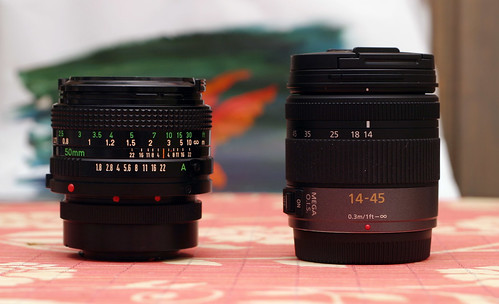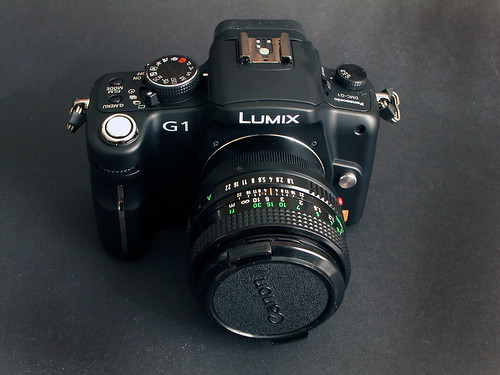 Shown to the left is my Canon FD 50 f1.8 which is essentially the same "nifty fifty" so popular among EOS camera users.
Shown to the left is my Canon FD 50 f1.8 which is essentially the same "nifty fifty" so popular among EOS camera users.Actually while it lacks a few features that the nifty fifty (AKA the EF 50 f1.8 series one) it has a few advantages such as price (I paid US$6.00 for this one) and smooth manual focusing.
As you can see in the above image its more or less the same size as the G Vario 14-45 lens and infact weighs quite a bit less. In fact its 186g with the adapter vs 227g for the G Vario.
The neat thing is that you don't actually need more than one adapter if you stay with one series of lenses (and well ,the adapters aren't heavy or dear anyway).
For the green and newbie photographers (or simply those who cut their teeth in the age of automated every-bloody-thing) the lenses will loose all automation, meaning that they work in stop down mode only. I bought mine on eBay from a seller called ciecio7 (check him out on Toolhaus, personally I rate him very highly and I've been on eBay for nine years).
 This is the pair sitting together. In the case of the FD lens mount (unlike say Pentax K mount or simple screw mounts) there FD lens is a little complex (to allow the camera to get aperture information and also to open and close the aperture to give 'wide open' focusing not stop down focusing).
This is the pair sitting together. In the case of the FD lens mount (unlike say Pentax K mount or simple screw mounts) there FD lens is a little complex (to allow the camera to get aperture information and also to open and close the aperture to give 'wide open' focusing not stop down focusing).The mount has to insert into the lens and then rotate part of the interior of the lens *(unlike most modern mounts, and people actually bitched when the EF mount came out ... folks it was worth the pain).
With the lens mounted to the adapter its now ready to pop onto your G1

I have friends who do machining work for a living, and I have to say that this is a top quality bit of work. Attention to smooth surface, beveled edges for good grasping ... its a quality bit of gear.
Have a closer look at this here in this close up:

You can see the nice job done on all things (even the polishing).
{by the way, these images are taken with my little trusty Coolpix 5000 ... a fantastic little digital camera and seemingly lost to obscurity of time. If you want an amazing value for money table top small product photography camera look no further}This view shows up the only issue I have with this adaptor, and its as much related to the design of the FD lens and mount as anything. Because the lens is now not mating flush with a camera body that stainless steel mount is open to the air (as you can see) and will allow any dust / grit / whatever to get in there and gradually damage the mechanism.
Is this a problem? Heck it all depends on where you use the camera and how. I significantly doubt it would be a problem for water entry (like the rest of the camera would be a bigger problem ...) but it does look inviting for sand if you go to the beach.
Anyway I've passed this information on to the maker, so perhaps he will make iterative changes as time goes by.
 So, this is what it looks like on the camera.
So, this is what it looks like on the camera.Attention to detail in manufacturing has meant that the focus markers and aperture reference points are right in the center on the top (where they should be) and (if you start with the lens mounted on the adapter) even the red dot on the FD lens works nicely as a line up indicator when mounting the lens. Just as in normal Canon mounting you start with the red dot to the top and turn clockwise.
The lens works nicely on the camera although I would say I'd prefer to have it easily fully open for focus then stop down for taking. Not because the view finder is brighter that way (unlike optical SLR's) but because the focusing works better.
The only problem I have encountered is that Infinity is just a teensy bit forward of infinity (meaning that I can't get to infinity). I've included an image below taken at f2.8 to demonstrate what I mean.

Keep in mind when viewing it that this is a 100% crop from a section of a 4000 pixel wide image from a sensor which is 22mm wide. The lens was originally used for 35mm photography (like in the 1970's) where the film is 36mm wide. So the magnifications of any failure in tolerance in lens build quality are very high. To put a perspective on it if this sort of image density was being pulled from a piece of 35mm film, it would be similar to a 4600dpi scan (since the image density is about 182 pixels per mm). Personally I think this is WAY BEYOND what anyone would have ever expected out of a (even at the time) cheap lens.
Bottom line
This is fantastic and gets me a better result than my 10D with the EF 50f1.8. Since I'm now using this adaptor with a FD 300 f4 (and soon an FD 28 f2.8) then its cost is divided across multiple cheap high quality lenses and puts it well into the bargain category.
Addendum
After getting some extension tubes which were a very snug fit onto my adaptor (read I can barely get them on), I've just decided to have a go at making a small modification to the adaptor to make it more compatible with my lenses - shorten it.
I got some P320 wet and dry paper, and using a very flat laminex table top carefully lapped down the lens side of the adaptor. If you have no experience with manual arts working I don't recommend you to try this (but as I'm quite a tinkerer I thought I'd give it a whirl)
I worked in a careful circular motion (a mini version of the Karate kid's wax on - wax off) holding the adaptor evenly so as to not put uneven pressure on any part of the surface. I then changed grip every few circles to avoid unintentional uneven-ness.
After all traces of the front surface's anodization layer was removed I tried it on my 28mm lens at f2.8. There was a noticeable improvement in infinity focus.
I repeated this a few times (checking again after a minute or so of careful lapping) and its now so bloody close as to be totally satisfactory.
So, this seems to work in the case of the FD mount.










4 comments:
thank you for these articles! this is just as useful as the videos on youtube and vimeo.
I am using the same adapter with Canon FD 85mm F1.2L lens with my GH1. Then aperture ring on lens has no effect any more. However if I loosen the lens to adapter joint a little bit, then the aperture ring works for some extent (not fully). However this adapter works perfectly Canon FD 50mm F1.4 works perfectly. Please let me know if I am doing something wrong here.
Hi
first, have a read of this article http://cjeastwd.blogspot.com/2009/05/new-fd-lens-adapter-for-g1.html and see if you're doing the engagement right.
secondly are you using new FD or older breech lock? feel free to email my hotmail account which is pellicle
Thank you much for the fast respond. I am sorry I do not know what kind of mount my lens has (Canon FD 85mm 1.2L). The first lens in the following page is what I have.
http://www.mir.com.my/rb/photography/companies/canon/fdresources/fdlenses/85mm.htm
I tried to mount as described in the article many times. I can hear the click sound after the adapter is fully mounted to the lens. One the lens mounted I can see the diaphragm fully opens and then locks. By the way I am using a adapter labeled as "RJ Camera FD m4/3" and there green dot instead of red.
Do you think I am doing something wrong while mounting?
FYI. Without the adapter on the lens, the diaphragm gets closed i.e. goes to min aperture and even if I try to turn the aperture ring nothing happens.
Post a Comment